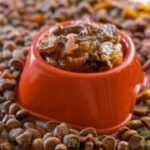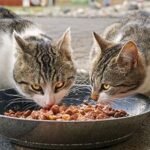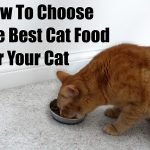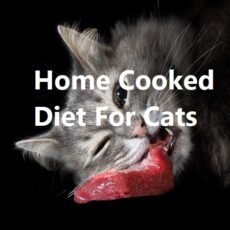16 Point Check List of What to Look for in Cat Food
Commercial cat foods come in all kinds of recipes formulated by companies keen to dominate the pet food market. The virtues of these cat foods will be plastered across their marketing. It is left to the consumer to plod through this information and the ingredients lists to determine what is best for their cat. In this article we point out, in layman’s terms, what to look for in cat food. We also provide a useful infographic tool for our viewers.
Dry vs Wet
Whether cat owners should be buying dry cat food as opposed to wet, or visa versa is not the aim of this discussion. In our view, both have merit, and both can have flaws.
It isn’t whether the food is dry or wet that is important, but rather the quality of the ingredients and formula. There are some excellent dry cat foods and there are some excellent wet cat foods.
What is Considered a Quality Cat Food?
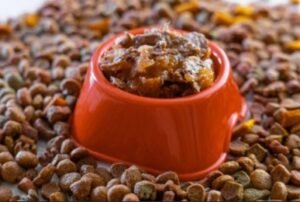 A quality cat food will be a well-balanced meat-based formula providing all the nutritional requirements that cats require, without the inclusion of harmful additives.
A quality cat food will be a well-balanced meat-based formula providing all the nutritional requirements that cats require, without the inclusion of harmful additives.
The Cat Food Advisor Team have researched and analyzed countless cat foods. By reading the ingredient’s lists of the different products it is a relatively simple task to determine which offers the best cat nutrition.
Checklist of What to Look for in Cat Food
Here is a useful check list designed to guide our viewers with assessing and selecting a premium cat food.
Simply, copy and print the infographic or save it to your device, then utilize it when reading ingredient cat food lists.
We have elaborated upon the details of this Checklist below.
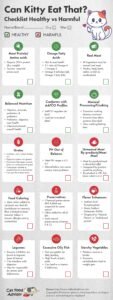
Share this Image On Your Site
What to Look for in Cat Food- 6 Must Haves!
-
Meat Protein/Amino acids
Cats are obligate carnivores deriving their protein from meat. Adult cats require above 25% protein dry weight from meat in their food.
Protein is broken down into amino acids. There are many amino acids essential for cats. An important one, which cats are unable to synthesize, is Taurine.
-
Omega Fatty Acids
Fatty acids contain anti-inflammatory properties and are essential nutrients for skin and coat health.
They need to be present in the correct ratio/balance in cat food. This ratio is 5 to 1 for Omega-6 to -3. Health problems can occur if the ratio is out.
-Omega 3 Commonly found in oily fish meat.
-Omega 6 Commonly found in chicken fat.
-
Real Meat
The #1 ingredient on the ingredient’s list should always be named real meat. The better meats are poultry, beef, lamb, rabbit, or fish (in moderation).
-
Minimal Processing and Cooking
In the wild, cats derive all their nutrients from raw meat.
The process of cooking destroys many nutrients such as vitamins, probiotics, and essential amino acids such as Taurine.
Very high temperatures during cooking will alter the molecular structure of proteins, making them harmful for cats. Slow cooking and baking are better cooking methods.
-
Balanced nutrition
Ensure a range of vitamins, minerals, probiotics, and prebiotics are present in cat food. Probiotics can help with digestive tract health, and vitamins and minerals maintain overall health.
-
Conforms with AAFCO Profiles
The Association of American Feed Control Officials regulate the production and sale of cat food. Look for the nutritional adequacy statement located on the pet food label to see if a product conforms to AAFCO Cat Food Nutrient Profiles.
10 Things to Avoid in Cat Food!
-
Grains
Avoid food with soybean, corn, wheat, barley, or rice. Carnivorous cats’ digestive systems are not geared for them.
Mycotoxin, a by-product of fungi and mold that forms on contaminated grains is damaging to organs, especially the liver.
Pet food companies use grains as a binder, especially in dry kibble. They will validate grains as a requirement for high fiber and essential carbohydrate, however, cats get these from meat.
-
PH Out of Balance
The ideal PH range for cats is 6.3 – 6.7. A PH above or below this range can cause crystal formation in the urinary tract resulting in painful infections.
-
Unnamed Meat By-products/Meat Meal
Meat by-product is the offal discarded in meat processing. Meat Meal is similar. Unnamed by-product could include anything from road kills, deceased pets to deceased zoo animals.
By-product meat is usually fine for cats, so long as you know what is in it.
-
Food Coloring
Food colorings are problematic to cat health. The main colors added to some cat foods are:
-Red 40: contributes to cancers
-Blue2: linked to brain tumors
-Yellow 5: causes allergies and genotoxicity
-
Preservatives
Chemical preservatives like butylated hydroxytoluene (BHT) and butylated hydroxy anisole (BHA) are very effective at preserving dry cat food but are suspected to be potentially cancer-causing agents. These chemicals are often added to oils and fats.
Look for natural preservatives such as Vitamin E and C.
-
Flavor Enhancers
Sodium Acid Pyrophosphate– synthetic palatant can cause dehydration, organ damage, cardiovascular disease and bone and tooth damage)
MSG Mono Sodium Glutamate– tricks the brain into thinking the food tastes good and can lead to obesity and brain cell damage
These will be disguised as “Natural Flavors’ or “hydrolyzed protein”
-
GMO
Genetically Modified Organisms (GMO) have been linked with diseases of the liver, pancreas, renal and reproductive system.
Look for non-GMO, or better still, organic ingredients.
-
Legumes
Enzyme inhibitors found in legumes like peas and beans can interfere with digestion. These may be responsible for taurine and other amino acid deficiencies in cats.
-
Excessive Oily Fish and Fish Oil
Not an acceptable food for daily feeding. Fish contains high levels of fatty acids, which can lead to a vitamin E deficiency in cats, and painful conditions. Some cats develop allergies as a result of eating too much fish based cat foods.
-
Starchy Tuberous Vegetables
Potatoes and sweet potatoes are included in many cat foods as a binder. Although not toxic, it is unnecessary to feed cats excessive carbohydrates as this leads to weight gain.
Final Thoughts
Being confident in knowing what to look for in cat food will relax cat owners when buying cat food. Please use our ‘What to Look for in Cat Food’ infographic to assist you.
Viewers are welcome to share the infographic with their friends who have cats. They may well appreciate this simple guide.



